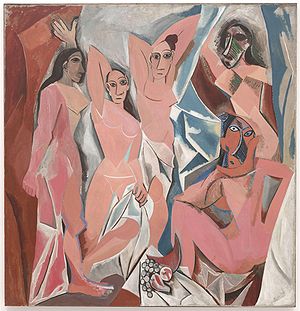Cubism (c. 1907 - 1921)
This article relates to Doghead

Asger inherits his love of art from Grandpa Askild, who paints in the Cubist style
pioneered by artists like Pablo Picasso, Georges
Braque, and Juan Gris, influenced by Paul Cezanne's later work. Although some art historians now credit the lesser-known Braque with creating the first Cubist paintings, Picasso's Les Demoiselles d'Avignon, painted in 1907, was long considered Cubism's precursor, and the beginning of modern art. Though it wasn't exhibited until 1914, it wrestles with ideas that would become central to the Cubist movement -- "the most important and influential single innovation in the early history of modern art," according to historian Simon Wilson.
 Les Demoiselles d'Avignon Les Demoiselles d'Avignon
by Pablo Picasso (2007)
|
Cubism didn't start so auspiciously, though; the style originally took its name from insults lodged by critics and salon-goers who complained that the paintings consisted of no more than tiny cubes that failed to accurately portray their subjects. Cubist artists painted objects and scenes from multiple angles, rearranging the pieces into sharp planes to create a complex, splintered whole rather than realistically portraying a subject in three-dimensional space. Indeed, Cubists delighted in drawing attention to the painting's existence as a two-dimensional, flat object and played visual and conceptual games that originated with the artistic tradition of
trompe l'oeil (fool the eye).
Like many early viewers of Cubist art, Grandma Bjørk expresses alarm and frustration at Askild's artistic style of choice. When he brings home a reproduction of Picasso's
Portrait of Ambroise Vollard (see image below), Bjørk has the following reaction: "Didn't the reproduction look like the image of Askild that she hadn't been able to piece together? And was it really true that there was no sense of coherence behind it? Merely an endless accumulation of fragments and sharp angles on which a person might cut herself?" This astute description presages Bjørk's eventual realization that the man she has married contains many hidden facets, that Askild has, as Asger claims, "a Cubist soul." Seen from one perspective, he is a heroic survivor of the Nazi concentration camps; seen from another, he is a bitter alcoholic who can't keep a job as a ship's architect due to drafting fanciful, impractical sketches influenced by his love of Cubism.
Despite Cubism's modern ethos, it usually focused on traditional subject matter: still-lifes, landscapes, figure studies, and portraits. Askild arguably expands Cubism's scope by applying it to narrative scenes, such as Niels's birth (
New Life in the Old Privy), granddaughter Stinna's childhood obsession with stealing mail (
The Vandal Gets Stuck in the Letter Box), and Asger's misadventures in the cellar (
The Liar Trips Over His Own Story). And although he idolizes Picasso, Askild most accurately follows the trajectory of Edvard Munch, one of Norway's most famous artists. Best known for Expressionist works like
The Scream, Munch, like Askild, eventually abandoned the frenetic style of his youth and middle age to take up a more measured, peaceful exploration of landscapes.
When Askild destroys his early paintings, he makes it possible for Asger to paint his own multi-faceted interpretations of Eriksson family lore. Writer Guillaume Apollinaire once said of Cubism: "Everyone must agree that a chair, from whichever side it is viewed, never ceases to have four legs, a seat, and back, and that if it is robbed of one of these elements, it is robbed of an important part." In the same way,
Doghead would be diminished if it did not contain so many flickering perspectives on the family's saga as a whole.
Filed under Music and the Arts
 This "beyond the book article" relates to Doghead. It originally ran in April 2009 and has been updated for the
July 2010 paperback edition.
Go to magazine.
This "beyond the book article" relates to Doghead. It originally ran in April 2009 and has been updated for the
July 2010 paperback edition.
Go to magazine.
This review is available to non-members for a limited time. For full access become a member today.
Membership Advantages
- Reviews
- "Beyond the Book" articles
- Free books to read and review (US only)
- Find books by time period, setting & theme
- Read-alike suggestions by book and author
- Book club discussions
- and much more!
-
Just $60 for 12 months or
$20 for 3 months.
- More about membership!

 Les Demoiselles d'Avignon
Les Demoiselles d'Avignon![]() This "beyond the book article" relates to Doghead. It originally ran in April 2009 and has been updated for the
July 2010 paperback edition.
Go to magazine.
This "beyond the book article" relates to Doghead. It originally ran in April 2009 and has been updated for the
July 2010 paperback edition.
Go to magazine.